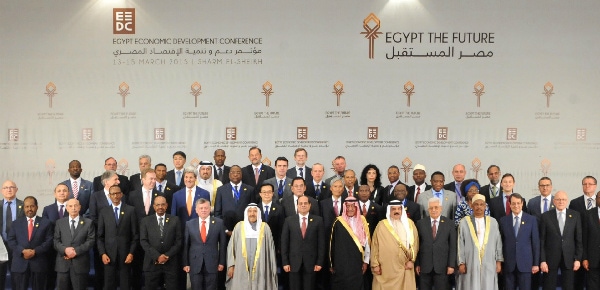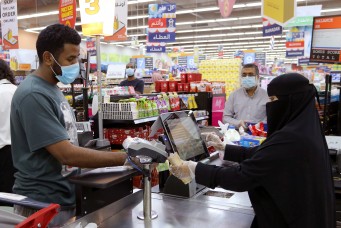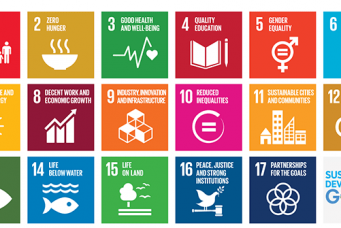Egypt’s Liberal Economic Agenda
Egypt is back in the favor of global business, but will it be able to sustain that interest?

Delegates of the Egypt Economic Development Conference pose for photos, Sharm El-Sheikh, Egypt, March 13, 2015. Pan Chaoyue/Xinhua Press/Corbis
When the Egyptian Ministry of Finance decided at the start of 2015 to issue its first Eurobond since the fall of the Mubarak regime, it received bids from nineteen global and regional banks for the mandate to arrange the transaction. The strong interest in the deal and the big turnout of international CEOs at the economic conference held in Sharm El-Sheikh in March showed that Egypt is back in favor in the eyes of global business. Egypt has been here before—the mid-1970s Open Door policy, the “Tiger on the Nile” phase in the mid-1990s, and the boom in foreign investment during the early part of the tenure of Prime Minister Ahmed Nazif’s government—and it has not always ended well. Will this latest effort to propel Egypt onto a plane of high growth driven by investment and market-based reforms do any better?
The reasons why the previous growth spurts petered out included domestic and global economic factors. Sadat’s Open Door policy stimulated a flood of imports and a surge in Egypt’s foreign debt, a problem that was exacerbated by soaring interest rates. In the late 1990s Egypt was affected by the backwash from the Asian debt crisis. Later, the final years of the Mubarak era were affected by rising commodity prices, which pushed up inflation, and by the impact of the global financial crisis, which put a brake on investment and on job creation in the private sector. There were also serious internal deficiencies with economic policy, which was at times over-cautious, and which was compromised by corruption. There was, moreover, an important political dimension. The benefits of higher growth were not shared by the estimated 25 percent of the population that remain below the poverty line. Moreover, there was deep resentment at police brutality and the monopolization of power by a largely unaccountable business and security elite.
The economic policies of Prime Minister Ibrahim Mahlab’s government are essentially a repackaging of those of the Nazif administration. The political context is also similar, albeit with some power shifts within the security state, more serious security threats, a higher number of political prisoners, and an even more heavily compromised judiciary. The lynchpin of the economic policy team is Hany Kadry Dimian, an economist brought into the finance ministry by its former head, Youssef Boutros-Ghali, who had been the dominant intellectual force in Egypt’s drive for economic liberalization since the mid-1980s. Dimian is very much his own man, but he symbolizes the continuity between the Mubarak era and the present: he remained in the finance ministry for almost all of the post-2011 period, with a one-year break between his resignation in early 2013 and his appointment as minister in March 2014.
The main distinction that Dimian consistently makes in his policy presentations is in his emphasis on the requirement under the new constitution to increase the proportion of budget spending on health, education, and research and development. The government will raise spending to 10 percent of GDP by 2016/17, from about 7.2 percent now—a recognition of the importance of spending on social sectors, as well as of building effective safety nets to mitigate the impact of subsidy reforms.
To focus on social spending, the government has relied on aid from Gulf Arab states to buttress its finances. Since July 2013, Egypt has received $14.5 billion in cash and fuel donations from Gulf donors, as well as $12 billion in long-term deposits (including $6 billion in April 2015), according to the Central Bank of Egypt. Without the Gulf aid, Egypt’s fiscal deficit would have been 17 percent of GDP, compared with 12.8 percent including the aid, and Egypt’s foreign exchange reserves would have been exhausted. But Dimian has made clear that he regards the recent Gulf aid as exceptional. His approach for the current fiscal year and for 2015/16 and beyond is based on achieving realistic targets for reducing the deficit through a combination of savings on subsidy spending, increased tax revenue and higher rates of economic growth. Dimian’s pursuit of more tax revenue has met resistance from businesses and other parts of the government, in particular the Ministry of Investment. He has had to backtrack on plans to introduce taxes on capital gains and dividend earnings, in a serious blow to his domestic credibility.
Achieving higher growth rates is crucial to for the sustainability of Egypt’s public finances. Between January 2011 and June 2014, real GDP growth averaged 1.6 percent, according to the Ministry of Planning, compared with an average of over 5 percent in the previous five years. Growth picked up to 5.6 percent in July-December 2014, although the performance was flattered by its comparison with the turbulent period following the army’s removal of Mohammed Morsi from the presidency. Nevertheless, the figures suggest that the government can achieve its growth targets—6 percent by 2018/19—helped in part by the recent strong performance of manufacturing. Such an increase in economic growth rates would be the minimum required to realize any perceptible improvement in general living standards. And there are plenty of risks, both internal and external, that could blow this scenario off course.
The Sharm conference made clear that the government sees foreign investment as a crucial ingredient in stimulating growth. The first wave of new investment is heading for the energy sector, as foreign companies have been encouraged by improved commercial incentives and by reduced energy subsidies. Gulf investors are gearing up for a number of huge real estate and retail projects. The central bank’s decision to devalue the Egyptian pound by 6 percent since January has also whetted the appetite of foreign banks to return to the Egyptian Treasury bill market. This could boost portfolio investment inflows and free up more domestic bank finance for lending to Egyptian businesses. However, such an improvement in the government’s financial position will not automatically translate into a wider sense of economic wellbeing. For that to happen, the government will need to abide by its commitment to higher social spending.
Many of Egypt’s economic indicators are showing signs of improvement. The current policy mix of an expansionary fiscal policy, with selective tightening, and reliance on the private sector and foreign investors to stimulate growth, is rational and is being implemented in an effective and transparent manner. However, it will take a long time for these policies to have an impact on inflation, unemployment and poverty—issues that preoccupy much of the population. And more immediately, the question remains as to whether Egypt can build a healthy economy amid such political and judicial dysfunction as the country exhibits.
David Butter is an associate fellow in the Middle East and North Africa Programme at Chatham House, and the former editor of the Middle East Economic Digest
Subscribe to Our Newsletter





